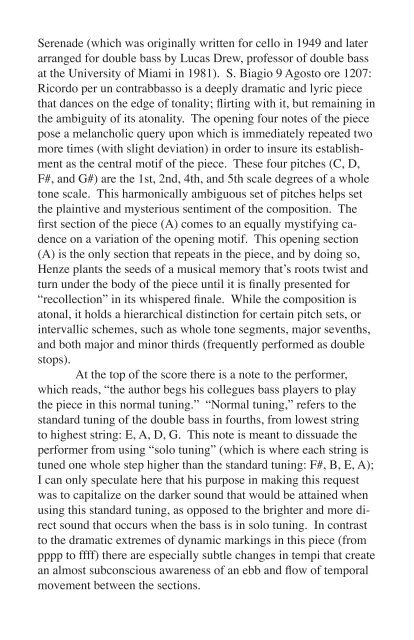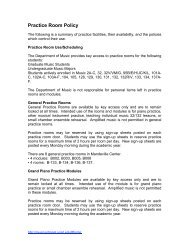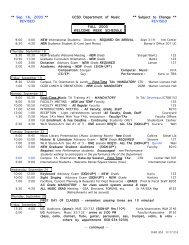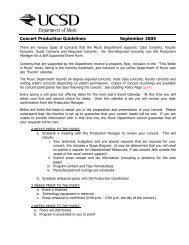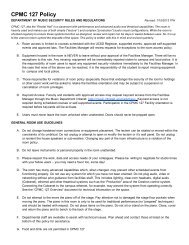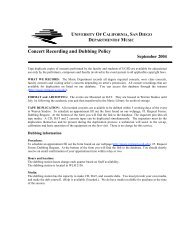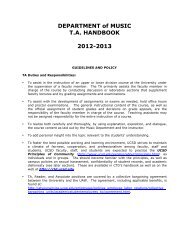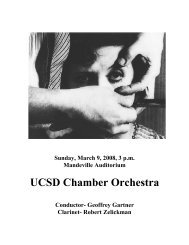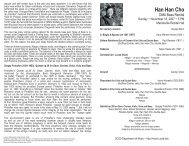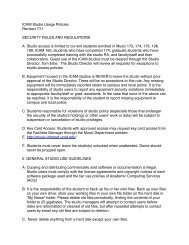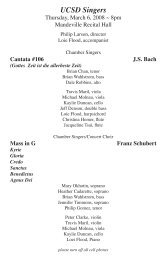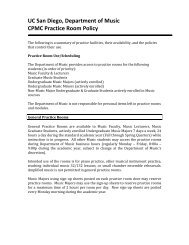Jeff Denson Contrabass Concert - Intranet
Jeff Denson Contrabass Concert - Intranet
Jeff Denson Contrabass Concert - Intranet
Create successful ePaper yourself
Turn your PDF publications into a flip-book with our unique Google optimized e-Paper software.
Serenade (which was originally written for cello in 1949 and later<br />
arranged for double bass by Lucas Drew, professor of double bass<br />
at the University of Miami in 1981). S. Biagio 9 Agosto ore 1207:<br />
Ricordo per un contrabbasso is a deeply dramatic and lyric piece<br />
that dances on the edge of tonality; flirting with it, but remaining in<br />
the ambiguity of its atonality. The opening four notes of the piece<br />
pose a melancholic query upon which is immediately repeated two<br />
more times (with slight deviation) in order to insure its establishment<br />
as the central motif of the piece. These four pitches (C, D,<br />
F#, and G#) are the 1st, 2nd, 4th, and 5th scale degrees of a whole<br />
tone scale. This harmonically ambiguous set of pitches helps set<br />
the plaintive and mysterious sentiment of the composition. The<br />
first section of the piece (A) comes to an equally mystifying cadence<br />
on a variation of the opening motif. This opening section<br />
(A) is the only section that repeats in the piece, and by doing so,<br />
Henze plants the seeds of a musical memory that’s roots twist and<br />
turn under the body of the piece until it is finally presented for<br />
“recollection” in its whispered finale. While the composition is<br />
atonal, it holds a hierarchical distinction for certain pitch sets, or<br />
intervallic schemes, such as whole tone segments, major sevenths,<br />
and both major and minor thirds (frequently performed as double<br />
stops).<br />
At the top of the score there is a note to the performer,<br />
which reads, “the author begs his collegues bass players to play<br />
the piece in this normal tuning.” “Normal tuning,” refers to the<br />
standard tuning of the double bass in fourths, from lowest string<br />
to highest string: E, A, D, G. This note is meant to dissuade the<br />
performer from using “solo tuning” (which is where each string is<br />
tuned one whole step higher than the standard tuning: F#, B, E, A);<br />
I can only speculate here that his purpose in making this request<br />
was to capitalize on the darker sound that would be attained when<br />
using this standard tuning, as opposed to the brighter and more direct<br />
sound that occurs when the bass is in solo tuning. In contrast<br />
to the dramatic extremes of dynamic markings in this piece (from<br />
pppp to ffff) there are especially subtle changes in tempi that create<br />
an almost subconscious awareness of an ebb and flow of temporal<br />
movement between the sections.


